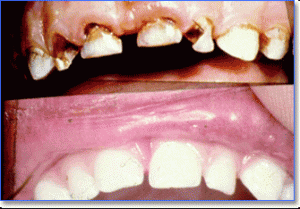
Nursing bottle decay in a young child, composite bonding is used to build up the crown
Dental Bonding or bonding teeth is a procedure whereby a material resembling natural teeth is joined onto the tooth surface. This is done to improve the appearance and function of the tooth. It is commonly used in fillings for decayed teeth. There are two types of Dental Bonding. Direct Dental Bonding and Indirect Dental Bonding. For Direct Bonding, the Dental Bonding agents which are used include composite (resins), GIC (glass ionomer cements) and ready made composite veneers. This procedure can usually be completed within 30 -45 minutes. In the case of Indirect Bonding, the Dental Bonding Agents used here would be porcelain veneers. Multiple visits are usually needed for this procedure as extra fabrication time in the lab is needed to custom make these porcelain veneers.
When do you need Dental Bonding:
- Decayed tooth surfaces
- Fractured tooth surfaces
- Discoloration of tooth surfaces
- Filling of gaps, especially on anterior teeth
- Replacing amalgam fillings which do not resemble natural teeth color.
- Worn out tooth surfaces due to the following reasons :
: Cervical (neck of the tooth) abrasions from toothbrush
: Erosion form acidic drinks
: Attrition (uneven tooth contact causing wear on the tooth)
Dental Bonding procedure:
Composite Bonding :
- The surface of the tooth is usually trimmed or shaped until all weak structures are removed. The size and shape of the cavity should be rounded and well defined to facilitate easy placement of composite and to enhance durability.
- An etchant (liquid chemical) that contains 35% phosphoric acid is used to roughen the tooth surface so that the composite can adhere to it.
- Next, a bonding agent that contains flow able composite is used. The flow able property is needed to ensure that the composite material can flow and adhere well to the roughen surface.
- Then the bonding agent is cured with a light cure device, to harden and set the composite.
- Now a layer of composite which has putty like consistency is applied and shaped to resemble the normal tooth contour. Finally a light cure device is again shone onto the restoration to harden and set it. If a big filling is done then composite is added and cured in layers.
- Finally the restoration is polished with a white stone to further enhance it’s resemblance to our natural tooth.
Ready made Composite Bonding or Porcelain Veneers:
- Little grooves are made on the tooth surface. The tooth surface is polished with pumice (abrasive material) to remove any foreign material on the tooth.
- Dental cement is mixed and applied onto the grooved surface and the ready made composite veneers are cemented onto the tooth surface.
- If an indirect porcelain veneer is used, an impression is first taken by the dentist (for custom fitting on the tooth) and sent to the technologist for fabrication before being cemented to the tooth.
Pros and Cons of Dental Bonding Agents:
Pros :
- Aesthetically pleasing because the shade matches and resembles natural teeth
- 100% non leaching of metal elements (amalgam fillings)
- Quite hardy, can last up to 3-10 years
- Can virtually restore any tooth surface
- Does not require special hygiene instructions and care
- Conservative on the remaining tooth substance
Cons:
- Expensive compared to metal fillings
- Can sometimes chip off and fracture easily, due to brittleness of material
Dental Bonding Cost and Prices:
The cost usually depends on the number of teeth which needs Dental Bonding, the area covered and the choice of Dental Bonding Agent to be used.
Note that insurance companies usually cover the cost for structural restoration of the tooth such as fractures and fillings. However they do not provide coverage for Dental Bonding done for cosmetic purposes because it enhances the appearance element more than structure and function. Direct and indirect veneers falls under Cosmetic Dental Bonding category.
Dental Bonding prices for fillings and fractures restored with composite bonding material usually ranges from $ 50 – $ 300.
Smaller restorations requiring less material will be cheaper compared to larger ones. Sometimes when more intricate carving and shaping is needed, the cost will increase accordingly. The area you live in also plays an important factor; more urban areas are more expensive.
Dental bonding prices for composite ready made veneers cost about $ 400 – $ 900 per tooth. So, if you need to veneer six anterior teeth, the cost will be six times more. Dental bonding prices for porcelain veneers cost about $ 900 – $ 1500 per tooth. It is more expensive because extra fabrication in the laboratory is needed. Porcelain veneers are however more hardy and durable so they last longer.
Dental Bonding Pictures:
Dental Bonding before and after pictures shown below:
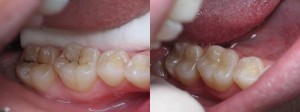

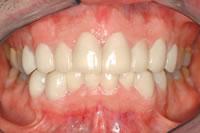

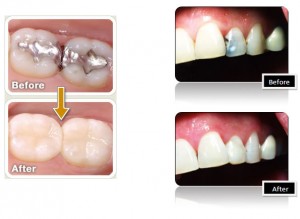
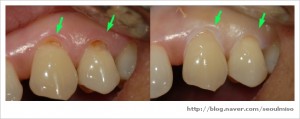
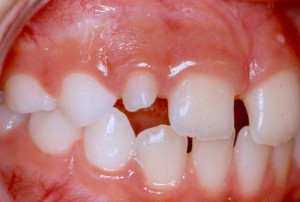
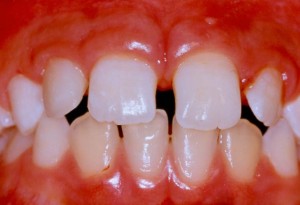


Pingback: buzzup.com
Pingback: Tweets that mention Dental bonding | Intelligent Dental -- Topsy.com
So nice examples of the work. If you have the money your should go for crowns rather than veneers as I have found the crowns last longer than veneers.
Pingback: Are Dental Veneers for You? | Intelligent Dental
Pingback: dropjack.com
Pingback: Most asked questions on Dental Implants part 3 | Intelligent Dental
Pingback: How Dental Bonding Can Improve The Appearance Of Teeth | Dental
Pingback: How Dental Bonding Can Improve The Appearance Of Teeth | Kyle Eberlein, DDS Dentist Serving Euless Texas Helps You, Your Spouse and Children With All Your Dental Procedures